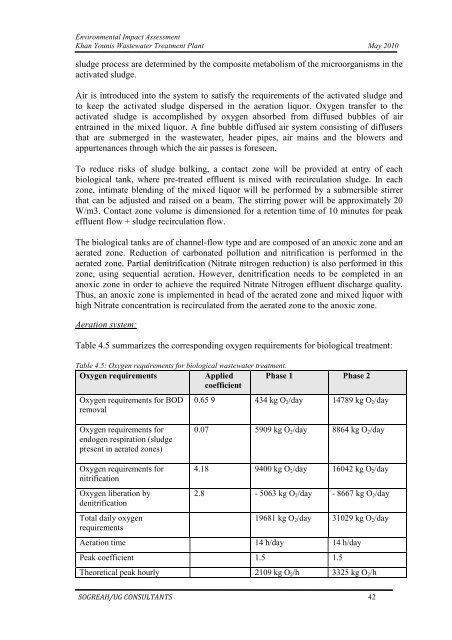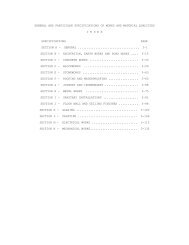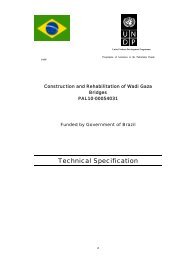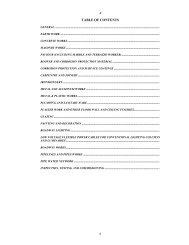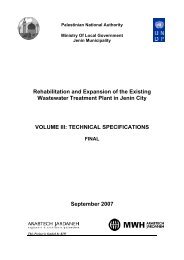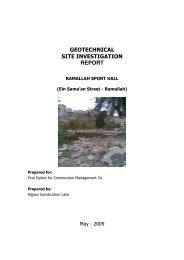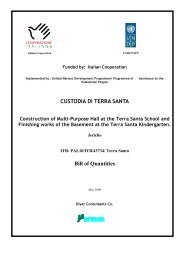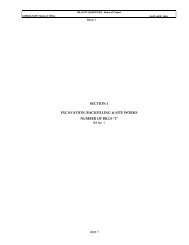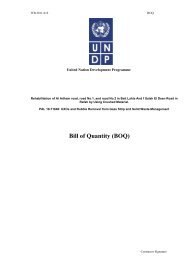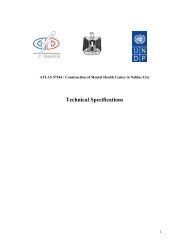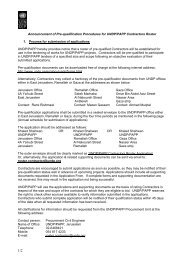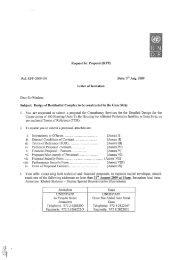EIA Study- Final Report-May 10 - UNDP
EIA Study- Final Report-May 10 - UNDP
EIA Study- Final Report-May 10 - UNDP
You also want an ePaper? Increase the reach of your titles
YUMPU automatically turns print PDFs into web optimized ePapers that Google loves.
Environmental Impact Assessment<br />
Khan Younis Wastewater Treatment Plant <strong>May</strong> 20<strong>10</strong><br />
sludge process are determined by the composite metabolism of the microorganisms in the<br />
activated sludge.<br />
Air is introduced into the system to satisfy the requirements of the activated sludge and<br />
to keep the activated sludge dispersed in the aeration liquor. Oxygen transfer to the<br />
activated sludge is accomplished by oxygen absorbed from diffused bubbles of air<br />
entrained in the mixed liquor. A fine bubble diffused air system consisting of diffusers<br />
that are submerged in the wastewater, header pipes, air mains and the blowers and<br />
appurtenances through which the air passes is foreseen.<br />
To reduce risks of sludge bulking, a contact zone will be provided at entry of each<br />
biological tank, where pre-treated effluent is mixed with recirculation sludge. In each<br />
zone, intimate blending of the mixed liquor will be performed by a submersible stirrer<br />
that can be adjusted and raised on a beam. The stirring power will be approximately 20<br />
W/m3. Contact zone volume is dimensioned for a retention time of <strong>10</strong> minutes for peak<br />
effluent flow + sludge recirculation flow.<br />
The biological tanks are of channel-flow type and are composed of an anoxic zone and an<br />
aerated zone. Reduction of carbonated pollution and nitrification is performed in the<br />
aerated zone. Partial denitrification (Nitrate nitrogen reduction) is also performed in this<br />
zone, using sequential aeration. However, denitrification needs to be completed in an<br />
anoxic zone in order to achieve the required Nitrate Nitrogen effluent discharge quality.<br />
Thus, an anoxic zone is implemented in head of the aerated zone and mixed liquor with<br />
high Nitrate concentration is recirculated from the aerated zone to the anoxic zone.<br />
Aeration system:<br />
Table 4.5 summarizes the corresponding oxygen requirements for biological treatment:<br />
Table 4.5: Oxygen requirements for biological wastewater treatment.<br />
Oxygen requirements<br />
Applied<br />
coefficient<br />
Phase 1 Phase 2<br />
Oxygen requirements for BOD<br />
removal<br />
0.65 9 434 kg O 2 /day 14789 kg O 2 /day<br />
Oxygen requirements for<br />
endogen respiration (sludge<br />
present in aerated zones)<br />
0.07 5909 kg O 2 /day 8864 kg O 2 /day<br />
Oxygen requirements for<br />
nitrification<br />
Oxygen liberation by<br />
denitrification<br />
Total daily oxygen<br />
requirements<br />
4.18 9400 kg O 2 /day 16042 kg O 2 /day<br />
2.8 - 5063 kg O 2 /day - 8667 kg O 2 /day<br />
19681 kg O 2 /day 3<strong>10</strong>29 kg O 2 /day<br />
Aeration time 14 h/day 14 h/day<br />
Peak coefficient 1.5 1.5<br />
Theoretical peak hourly 2<strong>10</strong>9 kg O 2 /h 3325 kg O 2 /h<br />
SOGREAH/UG CONSULTANTS 42


